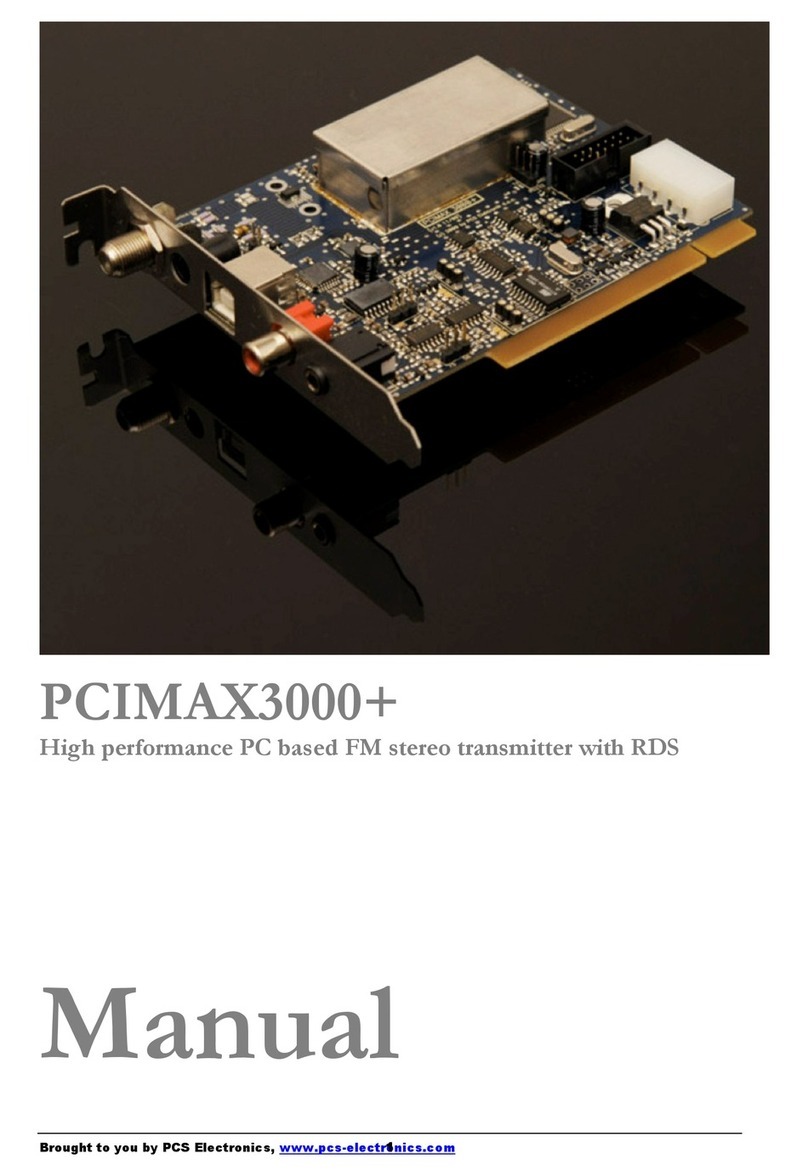Brought to you by PCS Electronics, www.pcs-electronics.com
Before you start
It is recommended that you read this section be ore you power your unit up or the irst time. Let us clear up some basics
you should know about. You will also ind some use ul tips in our guides and orum at http://www.pcs-electronics.com.
Here is what you need to get your TV transmitter on the air:
ntenna
Pre erred type o antenna is a ected by several actors, but mostly by desired radiation pattern, space available and your
budget. I you are located in the middle o the area you want to cover you'll need an omni-directional antenna which
transmits equally in all directions. I you are located at the edge o your desired coverage area you can beam the signal into
the target area with a directional antenna. Directional antennas are also practical or point-to-point communications.
Another thing to consider is that directional antennas usually have much higher gain than omni-directional antennas since
the power which is radiated in all directions with omni antenna is concentrated mainly into one direction with directional
antenna. Antennas with more gain thus have narrower beam. A compromise is usually made depending on budget and
space available, higher gain antennas are o ten bigger and o ten more expensive.
Once you’ve chosen and installed your antenna there is another thing to consider. You can read more about it in the next
section (So what is this SWR everyone talks about). Be ore powering up your transmitter on the air you should tune your
antenna to get minimal SWR. This is typically done by adjusting the position o the antenna and any adjustable pieces. Aim
or 2:1 or less. Use low power into the antenna when tuning it up and making adjustments. I you were using ull power and
a bit o the antenna came o in your hand the VSWR could be so bad as to blow the inal transistor. For the same reason
check the DC continuity o the antenna with an ohmmeter be ore plugging it in, to be sure it's what it's meant to be, either a
short circuit or an open one, depending on the antenna type. For instructions regarding construction o antennas please see
our website: http://www.pcs-electronics.com (guides section - antennas).
Antenna is a crucial part o the system so take special care. It is usually a good idea to place antenna away rom your
transmitter, power supply and audio system. Also any transmitter should be in a metal case which shields circuitry rom the
radiation o the antenna. I you cannot meet these requirements, you could experience eedback and other RF problems. We
cannot guarantee proper operation o any transmitter/ampli ier unless suitable antenna system is used and transmitters are in
ventilated metal enclosure! This applies to any transmitter. Interestingly, strong RF ield can make CD players and other
digital devices go bezerk. Try placing antenna next to yours and see what happens. Most o the modern audio gear is not RF
shielded – reducing costs is un ortunately the mantra today. This is why keeping antenna away rom audio gear is a good
idea, too.
I you are going to place your antenna outside, on your roo , please take care o the grounding. This should be done to
prevent lightning hazard and should be done by a company specializing in lightning protection. You can read more about
lightning protection in the book recommended below or many o the websites (Google up “lightning protection ham radio”
or example) .
I hope this basic introduction will not scare you too much, it should be su icient or the time being although we encourage
you to explore this exciting subject urther with the help o a book such as the ARRL Antenna Book:
http://www.amazon.com/exec/obidos/ASIN/0872598047/mightyspiraterad




























